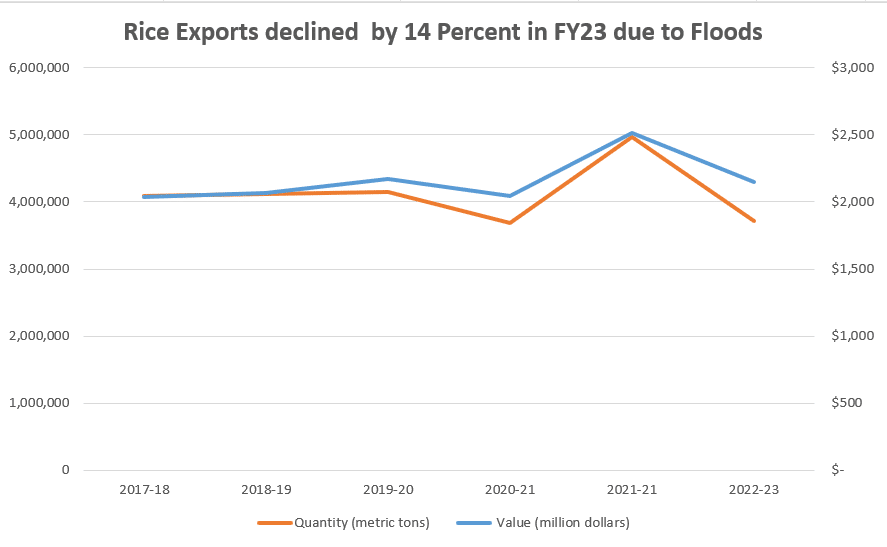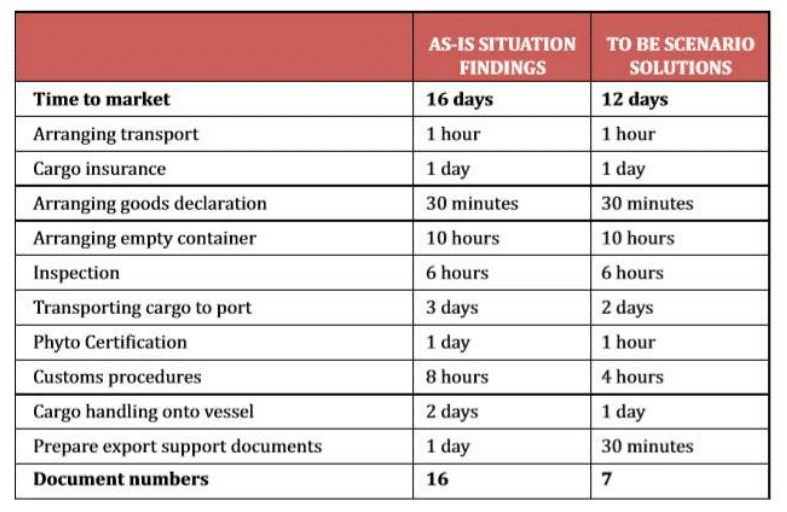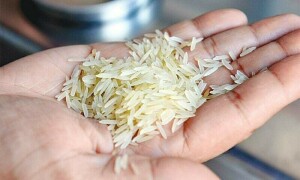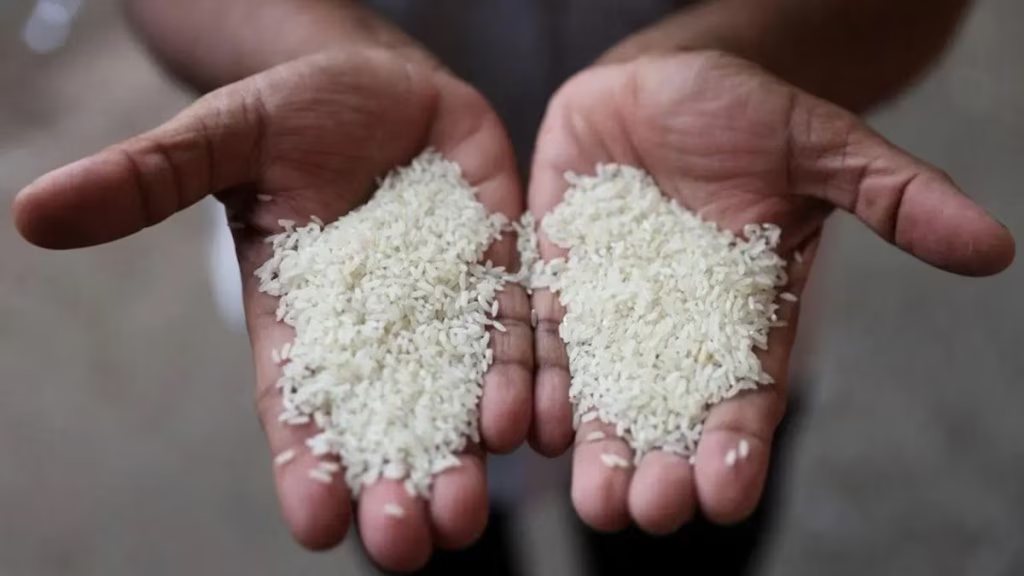Tags
Pakistan To Lose Rice Export Opportunity Without Policy Support

Pakistan’s Rice exports declined by 17.3 percent during the first two months of FY24 to $233 million from $283 million in FY23.
While the basmati rice exports increased by 8.2 percent, other categories which have a share of 80 percent in total rice exports (IRRI-6, IRRI-9, Broken etc.) declined by 28 percent.
The decline can be mainly attributed to lower inventories of other categories of rice and the fact that the harvest season of IRRI varieties is yet to begin next month, so an increase can be expected, but there are bigger problems hindering the country from achieving its true potential in $365 billion worth of international rice market.
Rice exports during FY23 also declined by 14.47 percent to $2.1 billion from $2.5 billion during FY22 with Basmati and other categories showed a decline of 6.3 percent and 17.5 percent respectively.
The decline was largely expected as devastating floods last year reduced national production by 21 percent, but this year’s expectations are high as output is forecasted to surge towards 9 million tons coupled with a number of other factors.

For starters, the world’s biggest rice exporter India banned the export of non-basmati varieties entirely, imposed a 20 percent duty on the export of parboiled rice and set a higher floor price of $1,200 per metric ton for the basmati varieties.
International rice prices have shot up to a 15-year high which has provided Pakistan with a unique opportunity to expand more into the market and increase its exports but are we doing enough to take advantage of that opportunity?
As per our conversations with an exporter, when trading directly with buyers in bigger markets like the United States, the cargo insurance requirements can cost as much as $2 million which is affordable for only a few in the market. To avoid that, most of the exporters try to trade with resellers in a hub like the United Arab Emirates (UAE) which not only reduces the margins but also brings more problems to the table.
Nabeel Yusuf, an agritech founder and marketing head at Hathor Trading LLC told ProPakistani how he lost three clients after facing regulatory hurdles during clearance of export shipments.
“We entered the rice trade to eventually uplift the farmers after realizing that providing a complete value chain is the only way forward in serving the farming communities properly”, said Yusuf talking to ProPakistani.
He added that while some hurdles might have made sense from the regulatory perspective in light of FATF requirements, there was no business logic behind the requests like credit verification. He said considering nobody produces such quality rice anywhere in the world except Pakistan and India, why couldn’t the government waive or ease down on some regulatory hurdles for the duration of the Indian ban?
He recalled that Pakistan had excess production of tomatoes and potatoes in the last few years and farmers either had to dump them in streams or plow them into fields since the market price did not justify even the harvesting cost. He said that the solution could have been to reach out to local and international buyers and provide these at lower prices but Pakistan can potentially lose this opportunity without policy support.
India has been outcompeting and undercutting Pakistan in the international rice market for decades due to the lower cost of production and simply having a better value chain. Even before the total ban, when India had nearly 20 percent duty on the export of non-basmati rice, its prices were lower than Pakistani rice in the international market.
Pakistan fundamentally lacks an agile policymaking that can swiftly adjust to the evolving market developments. There are too many moving parts in the system and by the time any action or more accurately, ‘reaction’ is taken, the impact is often insignificant.
In light of the recent Indian ban and rising international prices, there should have been initiatives taken to bring more people into rice exports by incentivizing both exporters and buyers, but there has not been any such development so far.
According to a 2020 Report by the Trade Development Authority of Pakistan (TDAP) on the rice sector, on average it takes 16 business days and the same number of documents for stakeholders to fulfill commercial and regulatory requirements of export business processes and get the Basmati rice from the exporter’s warehouse to the shipping vessel en route to the port of discharge in the country of destination.

The time includes nearly three days to transport the cargo to the port, two days in handling it onto the vessel, a whole day each for preparing export-related documents, getting cargo insurance and phyto certification and nearly ten hours to arrange an empty container.
Moreover, these are average figures from 2020 and at present this time more realistically stands at around 20-21 as per our conversations with exporters through legacy exporters who allegedly get the privilege of expedited processes and know how to cut these corners, but that leaves bottlenecks in the industry that scare new players from entering and bringing innovative approaches to the market.
One more thing to remember is that these are the requirements for existing exporters and the barrier to entry is much higher for new players in the industry.
If we are looking to compete with India, we need new minds with innovative approaches towards branding and marketing our product since lowering the cost of production is a long-term question and the answer to that relies on overhauling the whole agriculture sector but at least more focus on enabling better branding and marketing is at least a realistic ask.
“If someone wants to register a new company, he first has to go through Rice Exporter Association Pakistan (REAP), then chambers of commerce and getting membership at both places takes approximately 7–10 days”, stated Amit Kumar, a rice trader from Karachi talking to ProPakistani.
He added that in case of some steps like having packaging material, some exporters with capital can buy in bulk for swift processes but mostly the delays are experienced by all the exporters. He also mentioned that the export market has nearly crashed and totally gone silent in response to the decline in dollar exchange prices so that is also one of the challenges.
Kumar also said that prices of Pakistani rice have been so high in the last few years that exporters have been buying Indian rice and repackaging it as Pakistani brands. He added there is also a need to have better data availability regarding the data on how much we have essential commodities and how much we can export, so long-term decision-making can be done, and the government does not have to ban the exports abruptly or import the commodity later as happened with rice.
While we have to look beyond the Indian ban for sustainable solutions because that is a one-time event and might get revised by mid-October, we are failing to exploit this opportunity. On the other hand, India is gaining more economic profit by reportedly charging nearly $100 more per ton on granting ban exceptions for government-to-government contracts because they know how to make the most out of any situation.
In some good news, Mexico came all the way to Pakistan, ran multiple surveys and tests and finally decided to allow rice imports from Pakistan which had been banned since 2013. Russian markets have also opened to Pakistan and REAP stated in a recent statement that it’s confident that Pakistan’s Rice exports will cross the $3 billion mark this year in light of these developments.
It also added that the association had given a roadmap to the government to increase rice exports to $5 billion four years ago, but the implementation is still awaited. It also stressed the need to establish policy boards to keep an eye on the commodity demand and supply to make decisions on the export of commodities.
The government recently introduced the Pakistan Single Window (PSW) mechanism and got banks, customs, exporters, and clearing authorities in the same place, but it has a limited effect on reducing overall processes and barriers to entry. While the omens from Mexico, Russia and some other markets are looking, there is a question is that what our role is in enabling all of that.
There is a need to provide a truly one-window operation for exporters both new and existing to bring fresh ideas and energy to the table. This was the time to reduce all such hurdles for exporters so that most benefits could be reaped from this opportunity but no short or long-term policymaking is being done in this regard.
https://propakistani.pk/2023/09/20/pakistan-to-lose-rice-export-opportunity-without-policy-support/Published Date: September 21, 2023






